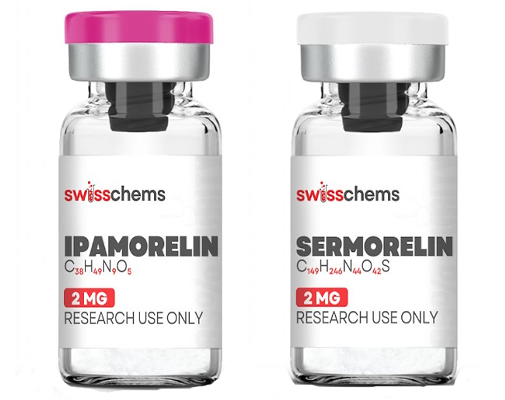Ipamorelin and Sermorelin have made a name for themselves as prominent peptides, each one offering unique benefits and intriguing mechanisms of action.
While they do share the common goal of enhancing overall health and wellness, the path each takes to reach that goal is different and presents some interesting parallels and points of contrast.
We’re going to go through all of the major points of comparison that you need to consider when researching new peptides or other supplements.
This comprehensive investigation will cover not just their function and how they perform that function, but their purported benefits, research findings, usage protocols, and even the potential side effects that a user may expect to experience.
Whether you’re a seasoned peptide user or someone just starting research on their first supplemental peptide, let this guide serve as your detailed walkthrough of Ipamorelin vs. Sermorelin.
Ipamorelin Vs. Sermorelin: Functional Differences
Note: This is a review. Click Here Now to pick up Ipamorelin and / or Sermorelin from our top rated source.
The primary function of both Ipamorelin and Sermorelin is to influence the levels of growth hormone (GH) in the body, albeit through very different pathways and mechanisms.
Learning how each of these peptides functions is a cornerstone to better understanding their distinct roles in peptide therapy.
Ipamorelin is categorized as a growth hormone secretagogue (GHS), and it functions by directly stimulating the pituitary gland to release GH.1 2
Its primary role is to be a lookalike for the hunger hormone ghrelin, which naturally increases GH levels when present.
This action makes Ipamorelin a potent GH stimulator, resulting in the various physiological benefits that are known to follow elevated GH levels, like enhanced muscle growth, better metabolism, and a lower body fat content.
Sermorelin, on the other hand, is a growth hormone-releasing hormone which mimics the action of GHRH, a naturally occurring hormone in the body, and binds with the same receptors, and stimulates the pituitary to produce and release GH.3
By directly stimulating the creation and secretion of GH, Sermorelin plays a critical role in helping to manage age-related GH production decline.
Since its function is more about helping restore a natural hormone level and rhythm, it is a popular choice in anti-aging circles.
Ultimately, both peptides aim to increase GH levels in the body, but the methods used to achieve this result are wildly different.
Ipamorelin functions as a ghrelin analog, leading to more direct stimulation of GH.
Sermorelin, functioning as a GHRH analog, works further upstream by causing a cascade that triggers the natural production of GH.
Ipamorelin Vs. Sermorelin: Mechanisms of Action
Ipamorelin, in the role of a GHS, operates mainly by mimicking ghrelin, which is responsible for hunger signaling.
When administered, Ipamorelin binds to ghrelin receptors in the pituitary gland.4
This binding triggers a cascade of biological processes that lead to the eventual release of GH.
The unique aspect of Ipamorelin’s approach is the high selectivity, in that it only targets the specific pathways that are related to GH release without impacting the levels of other hormones like cortisol or prolactin which are commonly impacted by similar GHS therapies.
This high selectivity makes Ipamorelin very appealing to individuals looking for the benefits of higher GH levels without the wider hormonal impact.
In comparison, Sermorelin is a GHRH analog and works by binding to GHRH receptors in the pituitary gland.
This stimulates the gland to produce and release GH but in a more physiological, natural rhythm-mimicking way.5
Sermorelin essentially enhances the natural signaling process that triggers GH production, which leads to a more gradual and controlled GH level increase.
This approach is more closely aligned with the natural hormone regulation systems of the body.
This makes Sermorelin a suitable choice for long-term therapies that hope to restore or maintain optimal GH levels, particularly in the context of aging or GH deficiency.
Ipamorelin Vs. Sermorelin: Benefits
Click Here Now to pick up Ipamorelin and / or Sermorelin from our top rated source.
The benefits of Ipamorelin vs. Sermorelin are very similar, however, the benefits tend to manifest in unique ways due to the different mechanisms of action.
Ipamorelin, through ghrelin mimicking and direct stimulation of GH release, offers some key benefits to users.6 7
It’s known for its effectiveness in helping to promote muscle growth and aiding in muscle recovery, making it a popular choice among athletes and fitness enthusiasts.
Additionally, the impact of Ipamorelin on GH levels helps contribute to an improved rate of fat loss, which is another appealing factor for those looking to gain additional body composition redefinition benefits.8
Another notable benefit of Ipamorelin is the minimal influence on cortisol and prolactin levels, making it a more targeted therapeutic option for individuals seeking GH increases without broader hormonal or systemic effects that come with other treatments.
On the other hand, Sermorelin also delivers significant benefits as a GHRH analog, particularly in the context of anti-aging.
By stimulating the body’s natural production and release of GH, it can help counteract some of the natural reduction in GH levels that are naturally associated with advancing age.9
This includes benefits of and improvement to skin elasticity and thickness, helping to potentially reduce the appearance of fine lines and wrinkles and helping to create a more youthful appearance in the skin in general.
Sermorelin has also been observed to improve sleep quality and general sleep cycle patterns, which are a critical aspect of general health, recovery, and rejuvenation.10
Additionally, the role of Sermorelin in helping promote improved bone mineral density and general bone health is particularly beneficial for older adults potentially at risk of osteoporosis.11
In short, Ipamorelin may be better suited for immediate goals like muscle building and fat loss, while Sermorelin may be better geared toward long-term comprehensive anti-aging and health-maintenance benefits.
Research Backing
Looking at the research that has been conducted into Ipamorelin vs. Sermorelin can help provide insights of significant value, and help underline their potential applications, respective benefits, and mechanisms of action.
Ipamorelin has been found, across various clinical studies, to show promising indications for enhancing GH levels while avoiding secondary hormonal impact in the context of cortisol and prolactin.
The effectiveness of Ipamorelin in stimulating muscle growth and helping aid fat loss has been specifically noted in research focusing on the anabolic effects.
Other studies have emphasized Ipamorelin’s safety profile and in particular, highlighting its minimal side effects, which makes it one of the more viable options for long-term use in GH therapy applications.
The research underscores Ipamorelin’s potential as a more highly targeted approach to boosting GH levels and may be especially beneficial for muscle development and body composition alteration and optimization.
On the other hand, Sermorelin has also been extensively studied, but for its role in anti-aging therapies.12
Clinical research has shown that Sermorelin can be very effective at restoring GH levels to a far more youthful state, leading to measurable improvements in skin health, sleep quality, and general energy levels.
Some studies have also demonstrated its positive impact on bone mineral density, showcasing why it’s considered an intriguing option for an agent to combat osteoporosis.
These research findings on Sermorelin not only back up claims of its efficacy in boosting GH levels, but also help illuminate some of the broader benefits it may have for improving the overall quality of life.
In short, Ipamorelin shows a stronger potential for bodybuilding and metabolic enhancement, while Sermorelin is recognized for its comprehensive anti-aging perks.
Ongoing research and clinical trials will continue to explore the full spectrum of their capabilities, promising to continually expand their applications as health and wellness therapeutic agents.
Usage, Dosage, & Cycling
While typically not a deciding factor when choosing between one peptide or another, the usage, dosage, and cycling information can be incredibly important for maximizing benefits while minimizing potential risks.
Ipamorelin is generally administered through a subcutaneous injection, with dosages varying from one individual to another based on the needs, goals, and advice of the preferred healthcare provider.
Common Ipamorelin dosages will range from 200 mcg to 300 mcg, taken one to three times daily.
The frequency and timing of the individual doses will depend on the specific objectives, such as muscle building, fat loss, or general wellness.
While the cycle time can vary, most users will follow a cycle length of 8 to 12 weeks, and then take a break.
This cycling will help prevent the body from becoming desensitized to the peptide, which will help maintain individual efficacy over time.
Sermorelin is also administered via subcutaneous injections, but the dosage for Sermorelin is typically between 200 mcg and 500 mcg per day, and it’s usually taken before bedtime to help mimic the body’s natural GH release cycle.
The duration of Sermorelin therapy courses can be longer than those of Ipamorelin and can go for several months to a year since it’s commonly used for anti-aging and to help improve the appearance of overall health markers.
Unlike Ipamorelin, Sermorelin will typically not require cycling, since it mimics the natural GHRH which allows for more prolonged, continuous use.
When storing these peptides, both are generally sold as lyophilized powders that need to be reconstituted with bacteriostatic water before they can be used, so proper storage is essential for maintaining potency and overall effectiveness.
The powders should be kept in a cool, dry, place until ready to use, and once reconstituted, the peptides should be fully used within a few days while kept in refrigerated storage.
Potential Side Effects
Considering peptide therapies, whether for Ipamorelin vs. Sermorelin or anything else, means considering the potential side effects as well.
While both of these peptides are generally well-tolerated by the body, there are some potential side effects that individuals should be aware of before adding either of these supplements to their health and wellness regimen.
With both Ipamorelin and Sermorelin, the most commonly reported side effects were related to the method of administration, which puts them on even footing there.
These side effects included discomfort or irritation at the injection site, along with mild symptoms like redness, swelling, itching, and general discomfort, that were mild in severity and went away on their own without any further attention.
Users of Ipamorelin may find that they experience headaches, nausea, or a sudden increase in hunger, which is due to the ghrelin-mimicking properties.
Due to the more targeted action of Ipamorelin, it’s less likely to cause any meaningful increases in cortisol or prolactin levels, lowering the risk of secondary side effects from imbalances in these hormones.
Sermorelin users may experience some side effects that are linked to elevated GH levels, such as potential joint pain, flushing, and rarely, hyperactivity of the pituitary gland.
As with any treatment that alters the body’s hormone levels, there is the potential for changes or disruptions in sleep patterns, as well as changes in glucose metabolism and management, so individuals sensitive to those changes should take care to monitor as needed or seek medical assistance to monitor during dosage changes or similar alterations in administration.
Ipamorelin vs. Sermorelin Review Conclusion
Ultimately, the choice between Ipamorelin vs. Sermorelin should be well-researched, and guided by individual health and fitness goals, existing medical conditions, medical history, and lifestyle considerations.
When beginning a new peptide supplement it’s essential to consult with a trusted healthcare professional to ensure your treatment is tailored to your individual needs.
As the body of research continues to grow, the potential applications of these peptides and more are likely to expand considerably, creating exciting new avenues in the realm of peptide supplements.
Click Here Now to pick up Ipamorelin and / or Sermorelin from our top rated source.
References
- Raun K, Hansen BS, Johansen NL, Thøgersen H, Madsen K, Ankersen M, Andersen PH. Ipamorelin, the first selective growth hormone secretagogue. Eur J Endocrinol. 1998 Nov;139(5):552-61. doi: 10.1530/eje.0.1390552. PMID: 9849822.
- Sigalos JT, Pastuszak AW. The Safety and Efficacy of Growth Hormone Secretagogues. Sex Med Rev. 2018 Jan;6(1):45-53. doi: 10.1016/j.sxmr.2017.02.004. Epub 2017 Apr 8. PMID: 28400207; PMCID: PMC5632578.
- Vance ML. Growth-hormone-releasing hormone. Clin Chem. 1990 Mar;36(3):415-20. PMID: 2107038.
- Sinha DK, Balasubramanian A, Tatem AJ, Rivera-Mirabal J, Yu J, Kovac J, Pastuszak AW, Lipshultz LI. Beyond the androgen receptor: the role of growth hormone secretagogues in the modern management of body composition in hypogonadal males. Transl Androl Urol. 2020 Mar;9(Suppl 2):S149-S159. doi: 10.21037/tau.2019.11.30. PMID: 32257855; PMCID: PMC7108996.
- Prakash A, Goa KL. Sermorelin: a review of its use in the diagnosis and treatment of children with idiopathic growth hormone deficiency. BioDrugs. 1999 Aug;12(2):139-57. doi: 10.2165/00063030-199912020-00007. PMID: 18031173.
- Greenwood-Van Meerveld B, Tyler K, Mohammadi E, Pietra C. Efficacy of ipamorelin, a ghrelin mimetic, on gastric dysmotility in a rodent model of postoperative ileus. J Exp Pharmacol. 2012 Oct 19;4:149-55. doi: 10.2147/JEP.S35396. PMID: 27186127; PMCID: PMC4863553.
- Gobburu JV, Agersø H, Jusko WJ, Ynddal L. Pharmacokinetic-pharmacodynamic modeling of ipamorelin, a growth hormone releasing peptide, in human volunteers. Pharm Res. 1999 Sep;16(9):1412-6. doi: 10.1023/a:1018955126402. PMID: 10496658.
- Gewehr MCF, Silverio R, Rosa-Neto JC, Lira FS, Reckziegel P, Ferro ES. Peptides from Natural or Rationally Designed Sources Can Be Used in Overweight, Obesity, and Type 2 Diabetes Therapies. Molecules. 2020 Feb 29;25(5):1093. doi: 10.3390/molecules25051093. PMID: 32121443; PMCID: PMC7179135.
- Walker RF. Sermorelin: a better approach to management of adult-onset growth hormone insufficiency? Clin Interv Aging. 2006;1(4):307-8. doi: 10.2147/ciia.2006.1.4.307. PMID: 18046908; PMCID: PMC2699646.
- Vitiello MV, Schwartz RS, Moe KE, Mazzoni G, Merriam GR. Treating age-related changes in somatotrophic hormones, sleep, and cognition. Dialogues Clin Neurosci. 2001 Sep;3(3):229-36. doi: 10.31887/DCNS.2001.3.3/mvvitiello. PMID: 22034239; PMCID: PMC3181657.
- Wüster C, Härle U, Rehn U, Müller C, Knauf K, Köppler D, Schwabe C, Ziegler R. Benefits of growth hormone treatment on bone metabolism, bone density and bone strength in growth hormone deficiency and osteoporosis. Growth Horm IGF Res. 1998 Feb;8 Suppl A:87-94. doi: 10.1016/s1096-6374(98)80016-6. PMID: 10993598.
- Chang Y, Huang R, Zhai Y, Huang L, Feng Y, Wang D, Chai R, Zhang W, Hu H. A potentially effective drug for patients with recurrent glioma: sermorelin. Ann Transl Med. 2021 Mar;9(5):406. doi: 10.21037/atm-20-6561. PMID: 33842627; PMCID: PMC8033379.







